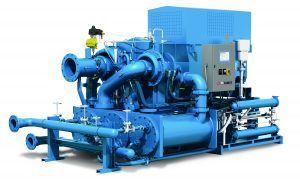Compressor surge and its detection
Many definitions of surge are used, but they all settle on stating that surge is an event in which the energy contained in the gas being compressed becomes equal, or larger than the energy imparted by the rotating impeller (or, set of blades) of the compressor. Essentially, energy accumulated in the compressed gas becomes greater than the energy level the rotating impeller of the compressor can sustain, and, as a result, the gas rapidly expands in an abnormal direction back through the compressor.

This article contains excerpts from the paper, "Compressor load sharing control and surge detection techniques" presented at the 2016 Turbomachinery Symposium by Serge Staroselsk, Wayne Jacobson and Medhat Zaghloul of Compressor Controls Corporation and Jeff McWhirter, an independent consultant.
Stall is another well-known phenomenon; at times it precedes the surge event and it may lead to the onset of surge. Surge is a very rapidly occurring event of gas expansion through the compressor, in most cases a loud sound can be heard by the observer.
Once the gas energy in the volume associated with the discharge of the compressor is dissipated by flowing back to the suction of the compressor, the operation of the compressor is returning back to normal, but if preventive measures are not taken, the compressor eventually proceeds back into the next surge. As a result, surge that is not aborted, becomes a cyclical event, with frequency dependent on the design of the compressor and, on piping and volumes of the process system (typically observed, surge cycle times are 1-5 sec. for centrifugal compressors, and 3-20 sec, for axial compressors).
Consequences of surge are: complete defeat and reversal of the balancing design of the rotating bundle of the compressor leading to abnormally high loads on bearings (especially thrust bearings) and seals; exceptionally high levels of vibration; rapid rise in the internal temperature of gas, and consequently, a rise in the internal temperature of the compressor; inability to meet flow and pressure demands of the process. For the majority of modern compressors surge is a highly damaging, sometimes a destructive event. The degree of damage to compressors during surge varies depending on design and application, and statistics are incomplete for obvious reasons. However, it is a common industry belief that a ½ hour of accumulated surge is detrimental enough for the compressor to become damaged beyond acceptable level. Operation of the compressor to the left of the SLL must be avoided and a surge event that evolved into surge cycling must be stopped immediately.
Generally, the occurrence of surge is inferred from a rapid change in any measurement that is a direct function of compressor flow or head. As mentioned previously, compressor flow, discharge pressure, and inlet temperature are signals that can be used for surge detection. However, based on experience, suction pressure can also exhibit surge induced oscillations. The Surge Detection System (SDS) should have several analog input channels available that can accept any of the above measurements. Since compressor flow dP will exhibit the most telling surge signature in almost all applications, the flow measurement should always be considered for surge detection. Other measurements such as discharge and suction pressure or suction temperature are selected based on the evaluation of the specific installation. In some instances, flow measurement may not be available. In these cases, motor current or power may be used instead of flow dP, provided that the signal produces a measurable surge signature. The SDS needs to accommodate any combination of these signals.
Instruments used for surge detection need to be located as close as possible to the compressor flanges. Locating the points of process sensing as close to the compressor as possible provides the quickest and most accurate information about the condition of the compressor. When selecting the location for the transmitter, vibration at the point of installation must also be considered. Installation on or near rotating machinery, or on a segment of pipe affected by vibration may produce adverse effects on the transmitter and its signal. Flow measurement in particular is susceptible to noise. Often, poor installation such as not allowing enough straight run piping upstream or downstream of the flow measuring device results in signal that is too noisy